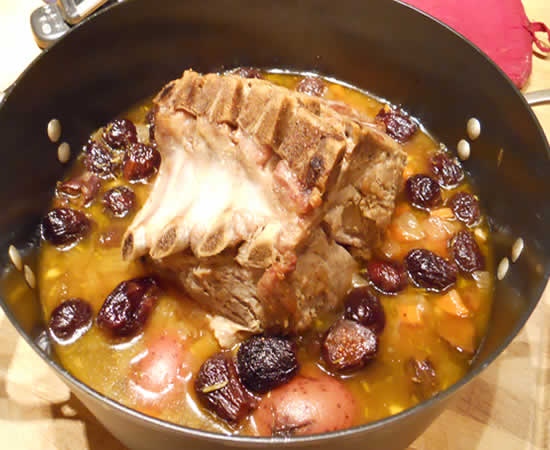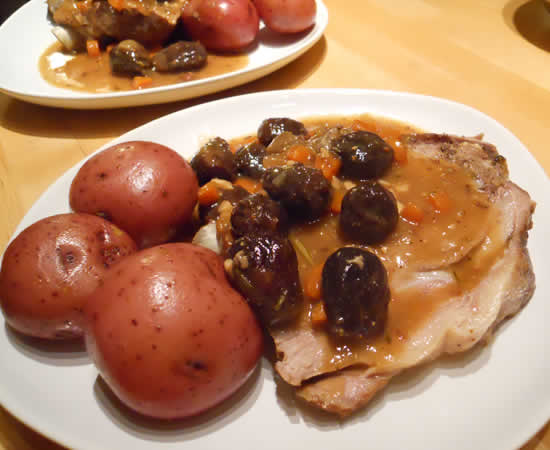
When I was grocery shopping last week, I came across a tub of bone-in pork roasts. It was January 2nd – the pork-and-sauerkraut-for-New-Year’s folks had bought what they needed. These were the leftovers and they were practically giving them away. I picked up a 6lb roast for next to nothing and immediately put it in the freezer. I had no idea what to do with it… I think in all my years, I had never cooked a pork loin blade roast.
I decided that needed to change, today!
I also needed to do a bit of research. I’m fairly confident in the kitchen, but the prospect of actually creating something good improves immensely when I know what the hell I’m dealing with.
First was to find out exactly what a pork loin blade roast is. A quick look in an ancient cookbook stated: The pork loin blade roast is part of the loin closest to the shoulder. It contains part of the blade bone, rib bones, and backbone. It also contains a large loin eye muscle surrounded by several smaller muscles. It is usually prepared by roasting or braising.
Perfect. Now I needed a recipe.
I looked through a few cook books and magazines but didn’t see anything interesting, so i headed over to Epicurious.com. I immediately saw a recipe for a Fig and Rosemary Pot Roast and knew I had my dinner for tonight!

This was a really easy meal to put together. It took all of about 10 minutes to get things in the pot and then it braised in the oven for a couple of hours, completely unattended.
It was savory with just a hint of sweetness from the figs. The recipe called for Calimyrna figs. I used Mission figs as they are my favorite and I always have them on hand.
Fig and Rosemary Pot Roast
Bon Appétit | October 2004
Bone-in cuts (like this pork loin roast) require a longer cooking time, but the payoff is big flavor and succulent meat. The meat closest to the bone is always the juiciest, and bone marrow enriches the sauce as the roast cooks.
Yield: Makes 6 servings
ingredients
- 2 cups dry white wine
- 1 8-ounce package dried Calimyrna figs, stemmed, halved lengthwise
- 1 tablespoon olive oil
- 1 6-rib blade-end or center-cut pork loin roast, chine bone removed, ribs cracked
- 1 medium onion, chopped
- 1 medium carrot, peeled, chopped
- 1 tablespoon chopped fresh rosemary
- 2 garlic cloves, chopped
- 1 14-ounce can low-salt chicken broth
- 1 tablespoon butter, room temperature
- 1 tablespoon all purpose flour
- 2 tablespoons Dijon mustard
preparation
Preheat oven to 300°F. Bring wine and figs to boil in small saucepan. Remove from heat and let stand until figs soften, about 15 minutes. Drain figs, reserving wine and figs separately.
Meanwhile, heat oil in heavy large ovenproof pot over medium-high heat. Sprinkle pork with salt and pepper. Add pork to pot and cook until browned on all sides, about 8 minutes total. Transfer pork to platter.
Add onion and carrot to same pot. Cover and reduce heat to medium-low. Cook until onion is golden brown, stirring occasionally, about 8 minutes. Stir in rosemary and garlic; sauté 1 minute. Add broth and reserved wine.
Return pork to pot, meat side down. Bring to boil. Cover and transfer to oven. Bake until thermometer inserted into center of roast registers 150°F, adding figs during last 10 minutes of roasting, about 1 1/2 hours.
Transfer pork to cutting board. Using slotted spoon, transfer figs to small bowl. Tent pork and figs with foil to keep warm. Spoon fat from surface of sauce. Bring sauce to boil. Stir butter and flour in medium bowl to blend. Whisk 1 cup sauce and mustard into butter mixture. Whisk mustard-butter mixture into sauce in pot. Boil sauce until thickened and slightly reduced, about 8 minutes. Season to taste with salt and pepper.
Transfer pork to platter, surround with figs, and pour sauce over. Carve pork between rib bones.
Came out great. I have to admit I wasn’t totally sold on the mustard, but it really did add a nice flavor.
Thank you, Bon Appetit!
